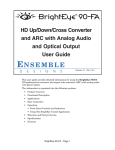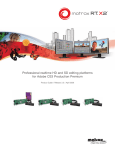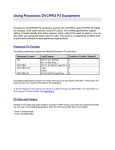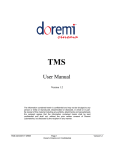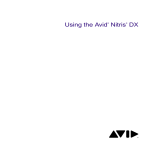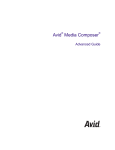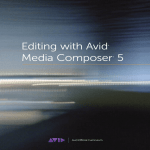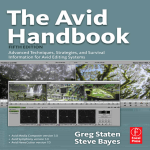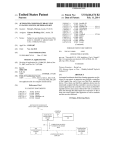Download Avid Editing A Guide for Beginning and Intermediate Users
Transcript
Avid Editing Fourth Edition This page intentionally left blank Avid Editing A Guide for Beginning and Intermediate Users Fourth Edition Sam Kauffmann AMSTERDAM • BOSTON • HEIDELBERG • LONDON • NEW YORK • OXFORD PARIS • SAN DIEGO • SAN FRANCISCO • SINGAPORE • SYDNEY • TOKYO Focal Press is an imprint of Elsevier Focal Press is an imprint of Elsevier 30 Corporate Drive, Suite 400, Burlington, MA 01803, USA Linacre House, Jordan Hill, Oxford OX2 8DP, UK © 2009, Samuel H. Kauffmann. Published by Elsevier Inc. All rights reserved. No part of this publication may be reproduced, stored in a retrieval system, or transmitted in any form or by any means, electronic, mechanical, photocopying, recording, or otherwise, without the prior written permission of the publisher. Permissions may be sought directly from Elsevier’s Science & Technology Rights Department in Oxford, UK: phone: (44) 1865 843830, fax: (44) 1865 853333, E-mail: [email protected]. You may also complete your request on-line via the Elsevier homepage (http://elsevier.com), by selecting “Support & Contact” then “Copyright and Permission” and then “Obtaining Permissions”. Library of Congress Cataloging-in-Publication Data Kauffmann, Sam. Avid editing : a guide for beginning and intermediate users/Sam Kauffmann.—4th ed. p. cm. Includes index. ISBN-978-0-240-81080-5 (pbk. : alk. paper) 1. Video tapes—Editing—Data processing. 2. Motion pictures—Editing—Data processing. 3. Avid Xpress. 4. Media composer. I. Title. TR899.K38 2009 778.59´3—dc22 2008044537 British Library Cataloguing-in-Publication Data A catalogue record for this book is available from the British Library. For information on all Focal Press publications visit our website at www.books.elsevier.com 09 10 11 5 4 3 2 1 Printed in the United States of America For Katie, Allie, and Derek This page intentionally left blank “Our deepest fear is not that we are inadequate. Our deepest fear is that we are powerful beyond measure.” —Nelson Mandela This page intentionally left blank Contents Introduction Acknowledgments Chapter 1 Getting Started The Editor’s Job Loading Your Avid Software The Many Parts of Your System Operating System System Memory Capture Boards Media Drives The Dongle Monitors Speakers The Client Monitor UPS Input Devices A Word About Timecode Avid Editing Workflow Gather Tapes, Files and Drives Create a New Project Capture/Import Create Bins Edit Add Titles and Effects Do Sound Work Output Your Project Getting Started The Avid Interface on Your Computer Toolset Menu Project Window Bins Clips Bin Views SuperBin xxiii xxvii 1 1 3 4 4 4 4 4 5 5 6 6 6 7 7 8 8 9 9 9 10 10 10 10 11 12 12 13 14 14 14 15 ix Contents Source Monitor Record Monitor Timeline Commands The Keyboard Three-Button Play The Spacebar The I and O Keys Other Important Commands Active Window Practice Starting an Editing Session Making Your First Cut Adding Shots to Your Sequence Ending an Editing Session Script for “Wanna Trade” 15 16 16 17 17 18 18 18 18 19 19 20 21 22 24 25 Chapter 2 Basic Editing Editing Rules Starting Your Second Editing Session Basic Editing Skills Marking Clips Splice and Overwrite Source Monitor Menu The Timeline Selecting and Deselecting Tracks Navigating the Timeline Home and End Snapping to Cut Points Position Indicator Single Frame Keys Changing the Timeline View The Timeline Fast Menu Scaling and Scrolling the Timeline Enlarge or Reduce Tracks Track Monitor Icons Marking Clips in the Timeline Duplicating a Sequence 27 27 28 28 29 29 30 30 30 31 31 31 32 32 32 33 33 34 34 35 35 x Contents Lift and Extract Trim Shots Using Extract It Takes Three Marks to Make an Edit Like a Mantra Using the Clipboard Undo/Redo List Suggested Assignments 36 38 38 39 39 39 40 Chapter 3 Trimming Trim Mode Trim Mode Practice Dual-Roller Trim Mode Leaving Trim Mode Lassoing the Transition Single-Roller Trim Mode Getting into Single-Roller Trim Mode Trim Frame Keys Review Transition Button Trim by Dragging Trim Practice Undo in Trim Mode Frame Counters More Practice Using Dual-Roller Trim Mode Split Edits or L-Cuts Removing a Split Edit Changing from Single-Roller to Dual-Roller Trim Mode Adding and Removing Rollers Advanced Trim Mode Techniques Trimming While Watching Trim One Side, Then the Other Dragging to a Mark Sync Problems in Single-Roller Trim Mode Enter Trim Mode on Selected Tracks J–K–L Trimming Trim Mode Review Getting into Trim Mode Getting out of Trim Mode 41 42 42 42 43 44 44 44 46 47 48 48 49 49 49 51 51 52 52 53 53 53 54 54 55 56 57 57 57 57 xi Contents Switching Trim Modes Add Rollers and Delete Rollers Drag the Rollers Trim While Watching Suggested Assignments 57 57 57 57 58 Chapter 4 The Project Window Creating a Bin All About Bins Bin Views Selecting Clips Working in SuperBin Mode Bin Headings in Text View Moving Columns Sorting Frame View Starting a New Sequence Drag and Drop Editing Deleting Sequences and Clips Getting Folders Settings: Have it Your Way User Profile Kinds of Settings Bin Settings Composer Settings Interface Keyboard Settings Changing Command Buttons Saving Your Screen Set-up Track Color Suggested Assignments Command Palette Tabs 59 59 60 60 60 60 61 63 63 63 64 64 65 66 66 67 68 68 69 69 70 72 73 73 74 74 Chapter 5 A Few Editing Tips When to Cut Continuity and Eye Trace Screen Direction Pacing 79 79 80 81 83 xii Contents Story Structure—Beginning, Middle, and End Documentary Issues Short is Better than Long Screening a Work in Progress Being Your Own Projectionist Grilling Your Audience Developing Thick Skin Suggested Assignments Chapter 6 Starting a New Project and Capturing from Tape Starting a New Project Standard Definition NTSC Interlaced Scanning Progressive Scanning NTSC Avid Project Choices The PAL Standard The SECAM Standard—Forgetaboutit High Definition Raster Type HDV™ DVCPro® HD Standard HD Connecting Your Equipment Cables Connecting HDV™ Cameras and Decks Configuring a Deck or Camera Naming Your Tapes Organizing Your Bins The Capture Tool Working with the Capture Tool If the Avid Says “NO DECK” Capturing Logging Batch Capturing Your Logged Clips Subclipping Video Resolutions Drive Space 84 85 86 86 87 87 88 88 89 89 91 91 92 92 92 92 93 93 93 95 95 95 96 96 97 97 99 100 100 100 102 103 104 105 106 106 107 xiii Contents Audio Audio Sampling Useful Settings Configuring Avid In/Out Hardware Devices Suggested Assignments 108 108 108 110 112 Chapter 7 Importing from P2 and Memory Cards The Panasonic HVX200 Working with P2 Cards and P2 Devices Choosing the Right Format and Frame Rate My Recommended Settings P2 is for Shooting, Not Editing Install P2 Driver Software Importing Directly from the Camera Using the PCMCIA Slot in the Computer Using Panasonic’s P2 Gear (AG-HPG10) FireStore™ Portable Hard Drive Recorder Accessing P2 Cards on a DVD or External Drive Backing Up Your P2 Media Protection Master Downconverting to SD Sony XDCAM EX Importing Other HDV Media Working with Imported HD Media 113 113 114 114 115 115 115 116 117 117 118 119 119 121 122 122 124 124 Chapter 8 Sound The Importance of Sound Importing an MP3 File or Audio From a CD Adding Audio Tracks Patching Audio Tracks Track Monitors Monitoring Only One Track The Hollow Speaker Icon Audio Scrub Selecting the Tracks for Scrubbing Scrolling Your Tracks Deleting Tracks Changing Audio Levels 125 125 126 126 127 127 128 128 128 129 129 129 129 xiv Contents Fixing Volume Output Levels Audio Mixer tool Speed Tips Panning Changing Volume and Panning on Multiple Clips Audio Data Auto Gain Placing Keyframes Automatically Waveforms Using Trim Mode with Waveforms to Fix Audio Equalization Setting the EQ EQ Templates Saving Your EQ Effect When to Use the Different Audio Tools What Level is Correct? Other Audio Techniques to Fix Problems Replacing Bad Sound Timeline Views Setting Up Your Tracks Pro Tools® Tell the Story First Suggested Assignments 130 130 132 132 133 134 134 136 137 138 138 139 140 141 141 142 143 143 143 144 144 144 145 Chapter 9 Segment Mode Editing Timeline Setting Extract/Splice Segment Mode Button Lift/Overwrite Segment Mode Button Moving Sound to Different Tracks Lassoing to Get into Segment Mode Suggested Assignments 147 148 148 150 152 153 154 Chapter 10 Advanced Editing Trimming in Two Directions Watch Point Slipping and Sliding Slip Slide 155 155 157 158 158 160 xv Contents J–K–L Trimming Replace Single Mark Editing Match Frame Mapping Menu Items to Keyboard Suggested Assignments 161 162 163 164 164 165 Chapter 11 Saving Your Work If it’s a Computer it will Crash Backing Up USB Flash Drives After the Crash Saving User Settings Copying User Settings The Attic Retrieving a File from the Attic Batch Capture Offline Media Backing Up Media Files Drag and Drop Your MediaFiles Folder Back Up Daily Suggested Assignments 167 167 168 169 170 170 170 171 171 172 173 173 174 174 Chapter 12 Titles Opening the Title Tool Choosing a Background Creating Your First Title Selection Tool Shadows Saving Titles Cutting Titles into Your Sequence Adjusting the Title Length Adding Fades to Your Title Colored Titles Blending a Title Creating Title Style Sheets Soft Shadows Glowing Titles Drawing Objects Delete Key 175 175 177 177 177 178 179 179 181 181 181 182 183 183 185 185 186 xvi Contents Titles with Objects Transparency Alignment Menu Lines and Arrows Other Buttons Changing or Fixing a Title Rolling Titles Cutting in Rolling Titles Rendering Your Titles Adjusting the Speed of the Rolling Titles Crawling Titles Marquee Suggested Assignments 186 187 188 188 188 189 189 189 190 190 191 191 191 Chapter 13 Effects Kinds of Effects Effect Palette Applying an Effect Applying More Effects Deleting Effects Real-Time Effects Effect Editor Effect Editing Tools Working with Keyframes Saving an Effect as a Template Effect Quick Review Adding Dissolves Freeze Frames Two-Field Motion Effects Motion Effects Slow Motion/Fast Motion Reverse Motion Strobe Rendering Two-Field Motion Effects Rendering Rendering Single Effects Rendering Multiple Effects Waiting for Effects to Render 193 193 194 195 196 197 197 198 200 204 204 204 204 205 206 206 207 207 208 208 208 209 209 209 xvii Contents Fixing Titles with Effect Mode Practice (or Else) 209 210 Chapter 14 Advanced Effects and Color Correction Advanced Effects Paint Clone Scratch Removal Picture-in-Picture (PIP) Advanced Keyframes 3D Warp or 3D Picture-in-Picture Color Correction Pulldown Menus Your Tools—Groups Automatic Color Correction Returning to Default Saving Your Color Correction Settings Color Buckets HSL Controls Curves Rendering Complex Effects A World of Effects 211 211 211 213 214 215 217 219 220 222 223 224 226 227 227 228 228 228 229 Chapter 15 Keeping in Sync Sync Problems The Source of Your Problems Sync Break Indicators Many Tracks Mean Many Sync Problems Locators Deleting Locators Editing Tricks to Stay in Sync Trimming in Two Directions—A Review from Chapter 10 Sync Locks Locking Tracks Suggested Assignments 231 231 232 232 232 233 235 235 235 236 240 240 Chapter 16 Importing and Exporting Importing Importing a Graphic File 241 241 243 xviii Contents Computers Versus Television Import Options Importing Color Bars Importing a QuickTime® Movie Exporting Preparing to Export Exporting a Production Still Exporting Motion Video Exporting a QuickTime® Movie Exporting a High-Resolution QuickTime® Movie Exporting a QuickTime® Movie for You Tube™, Google™, iTunes®, or Your Website Exporting a QuickTime® Reference Movie Exporting Audio to a Pro Tools® Work Station Going to Pro Tools® Exporting Other File Types Suggested Assignments 244 245 247 248 249 250 250 252 253 253 254 257 259 259 261 261 Chapter 17 Working in HD HD Primer DV 720p 1080i 1080p HDV™ All Those Pesky Frame-Per-Second (fps) Rates HD with the Mojo DX, Adrenaline, or Nitris DX Connecting the HD Deck to Your Avid HD Box Capturing HD with Adrenaline HD, Mojo DX, or Nitris DX Playback Performance Creating HD Titles and Importing HD Graphics Mixing SD and HD in the Timeline Using Transcode to Make a SD Version Downconverting HD Master Clips to SD Relinking to Your HD Media Downconverting an HD Sequence to SD Squeezed Switching from 16:9 to 4:3 Source/Record Monitors 4:3 Letterbox Version 263 264 264 265 265 265 266 267 268 269 269 272 272 272 273 273 274 275 276 277 277 xix Contents Pan and Scan Effect Crossconverting HDV™ to HD Have an HD Year 277 279 280 Chapter 18 Script Integration Hollywood-Style Editing An Example Using Two Monitors Naming Clips Getting the Script into the Avid Linking Clips to the Script Adding Takes Changing the Appearance of the Slate Adjusting Take Lines Moving Slates Deleting Takes and Slates Loading and Playing Takes The Tab Key Script Marks Placing Script Marks Manually The Fastest Way: ScriptSync Playing Marked Takes Looking at Your Coverage Page and Scene Numbers Find Script Off-Screen Dialog Only One Take Line Color Lines Identifying the Preferred Take Other Menu Items A Select Few Script for “Gaffer’s Delight” 281 281 282 282 283 283 284 285 287 287 288 288 288 289 289 289 291 293 294 294 295 295 296 296 297 297 297 298 Chapter 19 Finishing Online or Offline? Checking Your Audio Outputting to Tape Connecting and Powering Up a Deck or Camera 301 301 301 302 303 xx Contents Crash Recording to Tape Using the Digital Cut tool to Record Sequence Timecode Changing the Sequence Timecode Opening the Digital Cut tool HDV™ Sequence to HDV™ Tape Uprezing Your Offline Sequence Deleting Unreferenced Precomputes Preparing to Recapture Your Sequence The Recapturing Process Decompose Timecode Breaks Replacing Your Audio Tracks Recreating Title Media Output to DVD Using Sorensen Squeeze to Make a Progressive DVD or Blu-Ray™ Disc Creating a Blu-Ray™ Disc Done 303 304 305 306 308 308 309 310 311 311 312 312 313 313 315 316 316 Chapter 20 Shooting on Film, Cutting on Avid Why Film? The Film-to-Tape Transfer The 2:3 Standard Pulldown Film Transfered to Video Runs at 23.976 Types of Timecode Work Order to Your Lab and Telecine Instructions to Lab Instructions to the Transfer Facility for an Unsupervised Transfer Avid Project Format Sound and the Avid Synching Rushes Synching Tips Finishing Back to Film Feature Film Workflow Next Stop Cannes 317 317 318 318 319 319 320 321 321 322 322 323 326 327 327 328 Chapter 21 Present and Future Where Do You Go from Here? Information on the Internet 329 329 330 xxi Contents Getting a Job as an Avid Editor Other Avid Products Avid’s Future 330 331 331 Appendix: Menus File Menu Edit Menu Bin Menu Clip Menu Output Menu Special Menu Tools Menu Toolset Menu Windows Menu Script Menu Help Menu Tracking and Monitor Menus Tracking Menu Source and Record Monitor Menus 333 334 336 337 340 343 344 345 347 348 348 348 348 349 350 Index DVD Instructions 351 375 xxii Introduction Since the last edition came out in 2006, Avid has made significant changes to the way it operates. It has simplified its entire product line by cutting the Xpress™ line of software and building everything around Media Composer software. Avid is holding meetings all over the country and inviting editors to start a dialog about Avid’s products and support. Most incredibly, the company has lowered the price of the academic version of Media Composer to below that of Final Cut, so that a student with a valid student ID can purchase the industry’s leading software for under $300. I applaud these initiatives and the whole new way Avid is going about its business. Avid has always sold great editing software, but it’s often been overpriced, without great customer support. Now, you can’t help but marvel at the changes in price and value. This book concentrates on the latest Media Composer software, and, because that software offers so many more features, there is a great deal of new material in this edition. Every chapter has been rewritten to keep abreast of the changes in the production world and Avid’s responses to those changes. Chapter 6 demystifies the capturing process, including capturing HDV and DVCPro® HD tapes. Chapter 7 explains the entire P2 workflow so that you can easily import media from Panasonic’s P2 cameras and other P2 devices. It also tackles importing media from Sony’s memory cards. Chapter 14 explains how to use several advanced effects that you will find useful in your everyday work, such as Paint and Scratch Removal. The Color Correction tool is examined in much greater depth in this edition. Chapter 17 is devoted to working in HD and explains how you can easily create SD and HD versions of your sequences using Avid’s Transcode feature. Chapter 18 explains the use of ScriptSync™, the voice recognition software that makes Avid’s script-based editing a breeze. Think of this as a textbook, workbook, and user manual all rolled into one. It’s written so you can read it while lounging on a couch or sitting in front of an Avid following the book’s step-by-step instructions. Suggested assignments at the end of most chapters are there to encourage you to practice the techniques and skills explained in that particular chapter. The DVD that comes with the book contains exercises that will help you master some complex concepts. Because each chapter builds on the ideas presented in the previous chapter, it’s a good idea to practice one set of skills before moving on to the next. xxiii Introduction I believe you will learn to use the Avid more quickly if you start by editing a short narrative scene rather than a short documentary project. With a script for the scene in front of you, you know where you are going and you can concentrate on how to get there. To get you started, I’ve enclosed a short scene for you to edit entitled “Wanna Trade.” It’s on the DVD that comes with this book. Loading the project onto your Avid is amazingly easy. Look for “DVD Instructions” at the end of the book. You will simply be dragging some folders and files from the DVD to your computer. In Chapter 1, I have used “Wanna Trade” for most of my examples. There is also a two-page script for the scene at the end of the first chapter. If you’re in a class, ideally your professor, instructor, or teacher will mount the scene onto the Avid so you can begin editing after the first or second class. Inside the “Wanna Trade” project is a folder called “Chapter 3.” When you reach Chapter 3, open this folder and then the bin called “Trim Practice.” The sequence you’ll find in the bin has problems that you’ll correct using Single Trim Mode. It’s a great way to practice the trimming techniques outlined in Chapter 3. I have included a new project in this edition called “Kizza’s Portrait.” It’s on the DVD that comes with the book. It contains documentary footage about a six-year-old boy from Uganda who is HIV positive. The clips come from my film Living with Slim: Kids Talk About HIV/AIDS, which I shot while teaching video production at Makerere University in Kampala. (“Slim” is what many Africans call AIDS.) The film is used all over the world to educate people about the AIDS pandemic in Africa. It will help you practice your editing skills and introduce you to the plight of the millions of children who are born HIV positive. When you get to Chapter 16, you will import graphics from the DVD, including a title with and a title without an alpha channel. These will help you understand the import process and the way the Avid deals with transparency. The DVD also contains a second sequence called “Gaffer’s Delight.” Whereas “Wanna Trade” is a relatively easy scene to get you started, “Gaffer’s Delight” is more complicated and was shot in the 16:9 aspect ratio. This scene was covered by many different camera angles and involved several takes, making it a good candidate for using Avid’s Script Integration features, explained in Chapter 18. The script for “Gaffer’s Delight” is included on the DVD so you can bring the script into your Avid and then, following the instructions provided, attach clips to the action and dialog. Here you can practice using ScriptSync, the voice recognition software, to quickly join the “Gaffer’s Delight” script to the “Gaffer’s Delight” clips. We’ll use the “Countdown” included on the DVD when going out to tape in Chapter 19. xxiv Introduction Because Avid systems come on Windows and Macintosh platforms, I’ve used both Macintosh and Windows screens to guide you through the instructions. Mac and Windows screens are almost identical. The main difference between cutting on a Mac and cutting on a PC is the shortcut keys you use. On the Macintosh, you’ll often use the Command key (). If you are using Windows, you’ll use the Control (Ctrl) key instead. Windows users will also use the Alt key instead of the Macintosh Option key. That’s it. That’s about the only difference between the Mac and Windows versions. Obviously, no one book can hope to explain all of the Avid’s features or keep up with changes. I won’t show you every technique found in the Avid’s many manuals, but I’ll show you all the ones you need to know. The Avid’s interface is the most stable in the industry, and this edition should last you for many years. xxv This page intentionally left blank Acknowledgments I have many people to thank for their assistance, none more so than the many students I’ve had the pleasure to teach during the past decade. There are too many to name, but all of them taught me as much as I taught them. I want to give special thanks to Jeffrey and Marilyn Katzenberg. Their son, David, graduated from our film program, and after his graduation the Katzenbergs gave us a generous gift, which allowed us to move into high definition and outfit our Avid labs accordingly. David was a talented student and a joy to teach. Special thanks go to Avid employees Bob Russo, Greg Staten, Bob Barnshaw, and Ashley Kennedy for their many suggestions along the way. Loren Miller taught me how to use Avid’s software many years ago and I’m grateful to this day. My colleagues at Boston University have given me advice and encouragement throughout my teaching career. Jamie Companeschi, Jose Ponce, and Jim Baab all offered invaluable technical assistance and helped my students over difficulties whenever I wasn’t there. Jamie, Jose, and DP Bob Demers shot one of the scenes on the enclosed DVD-ROM. I also wish to thank Mary Jane Doherty, Bob Arnold, Geoff Poister, Bill Lawson, Alan Wong, and Charles Merzbacher. Thanks to Joanna Jefferson, Mary Choi, Brad Kimbrough, and my siblings, Margaret, Louise, and Bruce Kauffmann, who were my first friends and teachers. Special thanks to former students Kate Shanaphy and Tim Eberle, who are Kate and Tim in “Wanna Trade.” And thanks to actors Josh Wingate and Rachel Neuman, who play Peter and Michele in “Gaffer’s Delight.” This book could not have been written without Kate Cress, who gave invaluable support and advice every step of the way. xxvii This page intentionally left blank Chapter 1 Getting Started The Editor’s Job What does an editor do? Some say an editor’s job is to simply take out the slow parts. Others say it’s to follow the wishes of the director and to string together the best takes. Ask an editor what the job entails, and he or she will say it’s to breathe life into a film or video or to find and expose its heart and soul. Ask that same editor at the end of a long and difficult project, and you’ll probably hear, “It’s to make everyone else look good.” All are true, and yet none comes close to capturing the critical role the editor plays in any production. There are thousands of tasks involved in editing a film or video, and thousands of decisions must be made along the way. And all of them are important. Which take is best? Are the lighting and composition better in this shot or that? Is the pacing of these shots too fast? Will cutting out the character’s entrance make the scene more or less confusing? Although the editor’s primary job remains the same, the manner in which an editor works was transformed during the 1990s by the development of computer-based nonlinear editing systems (NLEs). The Avid was one of the earliest NLEs, and it is perhaps the best known system in the world. Today, the transformation from analog editing machines to computer-based editing systems is complete. Compared with analog devices, computer-based systems make the editor’s job much easier and faster, yet these systems can also make an editor’s job harder and take a lot longer to complete. It may seem like a paradox, but it’s true. 1 Avid Editing: A Guide for Beginning and Intermediate Users Editing on a computer is much easier and faster than on an analog machine because nearly every task is executed with a single keystroke or the push of a button. Yet, there is a price for all this speed. The Avid and the other popular computer-based systems are much more difficult to master than analog film or a video system. Today, when you buy an Avid, it comes with nearly 1500 pages of documentation. And, because the Avid comes with so many sophisticated tools, the editor is supposed to do things that were once handled by scores of other people. In the past, someone else designed and shot the titles, there was a team of sound and music editors, and a highly trained group of talented individuals created all the special effects. Now a single editor is often the entire post-production team! Today’s NLE editors are expected to be computer savvy while possessing video engineering skills. Often, an editor must set up, connect, and troubleshoot an incredible array of video decks, operating systems, audio drivers, and FireWire® cards. So, while it’s true that a computer can make an editor’s job easier and faster, it can also make the job longer and more difficult. An editor’s job has gotten more difficult and complex, but the rewards and satisfaction are greater as well. You, the Avid editor, have far more creative control over the project than at any time in the history of editing. You may have more to do, but you don’t need much help getting the job done, and you can make sure everything looks and sounds just the way you want it. Figure 1.1 Students at Makerere University in Kampala, Uganda, using Avid software. 2 Chapter 1: Getting Started Loading Your Avid Software Of the two main players in the NLE sweepstakes—Final Cut and Avid—only the Avid is a crossplatform system, meaning it runs on both Macs and PCs, either laptops or workstations. The Avid website maintains a list of qualified computers that are approved for the Media Composer family. Go to www.avid.com/products/media-composer/ and click on Tech Specs to check out the qualified computers and their specifications. Assuming you’ve got a qualified computer, running the correct operating system, loading the software is fairly straightforward. Put the SafeNet® dongle that comes in the pink bubble wrap into a USB port and insert the Media Composer DVD disk that comes in the box you got when you purchased the software. Double-click on the DVD, and you’ll see contents similar to Figure 1.2. Figure 1.2 Contents of Installer DVD. Open the README.pdf and note if your specific computer system has any issues that you may need to address. These README documents provide way too much information for the beginner, but you should read over the section “Before You Install the Editing Application.” Now, open the Other Installers folder and load the EDL Manager first. Then load the contents of the Goodies folder, and, last, install the Avid Media Composer software. It should take about five to ten minutes to install the software. The tricky part is that you should now go to the Avid website and download the latest version.Yeah, I know, you just bought the software, but that DVD has been sitting in the box for several months and problems that could cause you headaches may have been fixed since that DVD was shipped. Go to www.avid.com/support/downloadcenter/ and scroll down the page to “Additional Support Updates.” Find your Media Composer application. Pick the Mac or PC. Make sure there is a newer version and select it. The problem is you have to reinstall the whole Media Composer software, and it’s a big file to download from the web. Be patient, and you’ll soon have the latest version up and running. 3 Avid Editing: A Guide for Beginning and Intermediate Users The Many Parts of Your System Operating System Whether you have a Mac or a Windows PC, make sure it is running the correct Operating System version—Leopard,Vista, or whatever the site says. All Macs and PCs have system drives or internal hard drives. On a Windows computer it’s the C: drive, and on a Mac it’s the Macintosh HD (hard drive). Figure 1.3 Avid Media Composer on a PC laptop (courtesy of Avid Technology). System Memory As incredible as it sounds, your computer should have at least 4 GB of system RAM. Capture Boards Your computer must have IEEE 1394 FireWire® or i.Link™ to bring in both video and audio digital formats. All Macs and most PCs are sold with IEEE 1394 ports already installed. If your system doesn’t have such a port, you can usually add one via an add-in card. Media Drives In the past, all media drives were external to the computer, but today many computers have large internal drives that store media efficiently. Whether you store your media on an internal or external 4 Chapter 1: Getting Started drive, make sure you have 160GB or more. But, even if your computer comes with 160GB or more of storage, it’s often a good idea to store your project and media on an external FireWire® drive. That way you can carry your media to another Avid if your computer goes down or is needed elsewhere. How large should your external storage device be? Here, size does matter.You can store only about 4 hours of DVCPro® high-definition (HD) footage on a 160GB drive. Many people start with 320GB and go up from there. Figure 1.4 Media Composer on a MacBook® Pro with an external FireWire® media drive. The Dongle The Avid comes with a special key on a chain, called a dongle. You attach it to the CPU by inserting it into one of the USB ports. Without the dongle, you can’t launch your Avid software. The dongle prevents software piracy and enables certain functions, or extras, you may have purchased. Monitors It used to be that the Media Composer was designed to work with two computer monitors and the Xpress was designed for one. Now it’s your choice. Some people switch back and forth. When they are on the road, they use a portable computer with its single monitor, and when they are back home or at the office, they hook up a second monitor. 5 Avid Editing: A Guide for Beginning and Intermediate Users Speakers Sound is a critical part of any film or video, and having good external speakers is of utmost importance. If you are putting your own system together, don’t try to save money here. Plan on spending about $100 for a speaker system. The Client Monitor A monitor is helpful no matter which system you cut on. With digital video footage, a monitor may seem less critical, because you can’t alter the image coming into the system. But, you can change it once it’s in the Avid, and knowing how the signal will look on a television monitor once you put it back out to tape is important. The monitor has long been called a “client monitor” because it’s the one the client is supposed to look at when the editor hits Play. With widescreen LCD screens dropping in price, they’re a good choice because they can handle high- and standard-definition projects. You can pay over $25,000 for a top-of-the-line model, but smart shoppers can get a quality HD or SD monitor for under $1500. Figure 1.5 An Avid system with a high-definition client monitor. UPS When you spend thousands of dollars on a computer, you should consider buying an electrical backup device called a UPS (uninterruptible power supply). Because your work is important and because you can’t run a computer without electricity, common sense suggests that you plug the CPU, the computer monitor, and the media drives into this backup system, which provides a stable 6 Chapter 1: Getting Started electrical current and will keep everything running in case of a power failure. The idea is not that you keep editing, but rather that you use the backup power to save your work and then shut down your system. If you do not get a UPS, at least get a surge protector. Input Devices Many people use their cameras to capture tapes into their Avid system using a single FireWire® cable. This is especially true with HDV™ cameras. Although an added expense, a deck becomes a necessity whenever the camera is needed elsewhere. The Avid website maintains a list of supported devices that work well. Go to the page that lists specifications: www.avid.com/products/mediacomposer/. If the page moved (as they often do), search Avid’s website (www.avid.com). For capturing mini-DV and DVCAM tapes, I really like the Sony DSR-11 deck, which can handle NTSC and PAL DV tapes. Avid sells external interfaces such as the Nitris DX and Mojo DX. Both allow you to capture and play uncompressed HD signals. The Nitris DX is shown in Figure 1.6. It offers sophisticated HD compression and decompression, together with a huge variety of In/Out connections so you can connect your computer to digital and analog audio and video recorders. You can record to and from just about any deck, including VHS, S-Video, Beta SP, DigiBeta, and high definition decks. Figure 1.6 Avid Nitris DX. The Mojo DX is designed to bring in standard-definition digital signals via its serial digital interface (SDI) connections, as well as uncompressed high-definition signals, via its HD SDI connections. In order to connect to Avid’s Mojo DX and Nitris DX hardware boxes, your computer must have either an available PCI Express slot or an Express Card port. A Word About Timecode All NLE systems, the Avid included, are based on the videotape tracking system called timecode. As sound and pictures are recorded onto the videotape by means of a camera or deck, unique numbers, the timecode, are placed onto the videotape as well. There are approximately 30 frames of video per second, and each frame has its own timecode number. Whereas film numbers are based on the length of the film, timecode is measured in time. The first frame on the videotape is designated as 00 hours:00 minutes:00 seconds:00 frames, or 00:00:00:00.The next frame is 00 00:00:01. Since video 7 Avid Editing: A Guide for Beginning and Intermediate Users is based on 30 frames per second, after 00:00:00:29 the next frame would be 00:00:01:00. Because each frame has its own unique address—its timecode—it’s easy to keep track of them. Computers are good at numbers, so it is through timecode that the Avid keeps track of your pictures and sound. Avid Editing Workflow Editing a project with lots of different elements requires a great deal of organization. Gather Tapes, Files and Drives First, gather together all the picture and sound elements that form the source material for your project. These may include: ● ● ● ● ● ● Videotapes—HDV™, HD, DVCAM, DVCPro®, or miniDV Memory cards—Used by many cameras, such as the Panasonic HVX200, to store pictures and sound Audio—CDs Optical discs—Such as the Sony blue-laser discs, which can be recorded over hundreds of times and have a much longer shelf life than tape formats Picture and audio files—Computer graphics, animation, pictures, and audio files on a flash drive, CD, or DVD Hard drives—Such as those mounted on cameras that can be connected to a Mac or PC via FireWire® Figure 1.7 A Panasonic HVX200 with a P2 memory card (courtesy of Panasonic). 8 Chapter 1: Getting Started Be sure to develop an inventory system that will track all of these sources throughout the project in case you need to recapture or reimport them. Create a New Project When you start up the Avid software, it asks you to tell it which project to open. You might share an Avid with other students or other editors, all working on different projects. If you are beginning a new project, you would click the New Project button, name the project, and begin work on your new project. Capture/Import The Avid will open up the Project window for your new project. You can now begin to capture from your videotapes onto your computer’s media drives or import files from memory cards or DVDs. As soon as you capture or import your media, the Avid creates two things: a media file, which is the Avid’s digital version of your picture or sound, and a master clip, which is a virtual copy of the media file. Media files are stored on media drives. One media file is created for each track of picture and sound. If you have video and stereo sound, the Avid will create three media files for that digital material: one media file for the picture and two media files for the stereo sound recorded with that picture (see Figure 1.8). Figure 1.8 This single master clip is linked to three media files stored on the drive. You don’t edit or work with media files; you work with the master clip. Think of the master clip as a shot. You can edit the shot, duplicate the shot, or flip the shot, and all of these actions affect the clip, while the media file (the captured picture or sound) is safe on the media drive. Create Bins When you capture or import your source material, you organize it into bins. You might have a bin for all the material from tape number one and a second bin for all the audio files imported from a memory card. Bins are like folders on your home or office computer. The name comes from the 9 Avid Editing: A Guide for Beginning and Intermediate Users trim bins used to hold strips of film in the days of film editing. The Avid recognizes that you might be starting an ambitious project involving the creation of many bins, each holding up to 100 clips, and provides sophisticated search-and-find tools to help you locate just the shot you are looking for. Now that you have organized the material, it’s time to edit. Edit When you open up a master clip (think of an entire shot from head to tail) and select a part of it to be included in your project, you are making your first cut. The Avid calls any material that is cut together a sequence. You create a sequence by editing together clips. In traditional film editing, the editor starts by putting together an assembly, which includes all the clips that might appear in the final film, spliced together in the right order.You could call your first sequence an “assembly sequence.” Once you have assembled the material, the next stage is to create a rough cut, in which the clips are placed in the right order and trimmed to approximately the right length. You might name this a “rough cut sequence.” Because the material is digital, sequences are easily duplicated.You might create a sequence on Tuesday, duplicate it on Wednesday morning, and start making changes to it. At any time, you can open up the Tuesday version for comparison. As you get to the end of your editing, you are working on what is normally called a fine cut. Shots are trimmed to give each scene the right pace and timing. Add Titles and Effects Once you have edited your sequence, you can easily add titles and effects to it. The Avid has tools for creating multilayered effects and titles. Titles can be created and added to a sequence in minutes. Most effects take only a few seconds to create. When all the titles and visual effects have been added, you have reached the stage called picture lock. No more changes are made to any of the picture tracks. Do Sound Work Once you have reached picture lock, it’s time to add the many sound effects and music cues that will make for a rich and powerful sound track. The Avid can monitor up to 24 sound tracks, and by using built-in tools you can make intricate sound adjustments to any and all tracks. Output Your Project Finally, the end of the Avid workflow takes place when the final edited sequence is sent out into the world. The many output options include: ● ● ● ● 10 Record the finished sequence onto videotape. Create a DVD. Create an edit decision list (EDL) for an online videotape editing session. Turn your sequence into .AVI, .MOV, .WMV, or .MPG files for posting on the web. Chapter 1: Getting Started With that overview behind us, let’s turn on the computer, launch the software, and explore the workspace the Avid provides us.Your system may be set up in a slightly different manner than what is described here, but all systems are fairly similar. Getting Started If you haven’t already mounted the “Wanna Trade Scene” project found on the DVD that comes with this book (or that your instructor has loaded for you), this would be a good time. Make sure you Quit your Avid software if it’s open. Follow the “DVD-ROM Instructions” section found at the end of the book. Once you’ve finished, restart your computer and you’re ready to go. Figure 1.9 Students practice editing techniques in a classroom. If you have another project mounted and want to work on that instead, excellent. The process for launching your Avid is pretty much the same, whether you’re on a Mac or a PC running Windows. When the software is first loaded onto the system, a shortcut or alias is usually created and left on the desktop. When everything is turned on, you simply click on the shortcut or alias icon to launch your Avid software. Figure 1.10 An alias located in the dock To launch your Avid: on a Mac. Click it to launch. 1. Turn on the power to all the devices that make up your system. That means the speakers, the external media drives, the deck or camera, and the client monitor. 2. Press the Power key or button that turns on the CPU. Wait for the system to mount. 11 Avid Editing: A Guide for Beginning and Intermediate Users 3. If there is a log-on process, type in your user name and password. 4. Click on the shortcut or alias for the Media Composer or Xpress application. 5. When the Avid Project window appears, click on the project you have been assigned. If it’s on a different drive, click on the folder icon to browse in other drives (Figure 1.11). If it has been mounted, click on “Wanna Trade Scene.” 6. Click OK. The project will open, showing you the Avid interface. Click on the folder icon to browse for projects on external drives Figure 1.11 The Avid Interface on Your Computer Toolset Menu Before we begin editing, let’s make sure we are all using the same editing interface. Go to the menu bar at the top of your computer screen and pull down the Toolset menu. I want you to select the Source/Record Editing Mode, as shown in Figure 1.12. It’s probably already set that way, but if not let’s all start off on the same foot. Just drag your mouse down the menu list and click on Source/ Figure 1.12 The Toolset menu. Record Editing. Arrange the window to look like Figure 1.13. The Media Composer and Xpress applications can work with just one computer monitor, which shows the Project window containing all your bins, the Composer window containing the Source and Record monitors, and the Timeline (Figure 1.13). You select clips in the bins and place them in the Source Monitor, on the left, which holds the clips that will be edited into the project. The 12










































